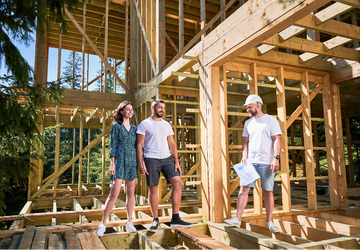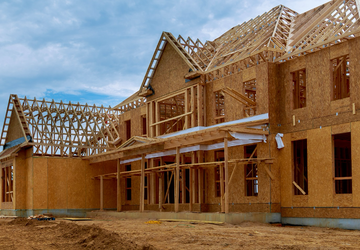Trends in New Home Construction and Their Implications
The trends in new home construction evolve along with the housing market. From innovative building materials to energy-efficient designs and smart home technologies, today's new homes are being built with the future in mind. Whether you are looking to build your dream home or simply interested in the future of housing, these trends offer valuable insights into what to expect in the years ahead.
The trends in new home construction evolve along with the housing market. From innovative building materials to energy-efficient designs and smart home technologies, today's new homes are being built with the future in mind. Whether you are looking to build your dream home or simply interested in the future of housing, these trends offer valuable insights into what to expect in the years ahead.
This blog explores the latest home building trends and examines the implications of construction trends for homeowners, builders, and the environment.
Sustainable and Eco-Friendly Building Materials - New Home Construction Trends

Use of Recycled and Renewable Materials
The construction industry is increasingly turning to recycled and renewable materials as a way to reduce waste and promote sustainability. By utilizing resources that are either repurposed or easily renewable, builders can minimize the environmental impact associated with traditional building methods. This conserves natural resources and encourages a more circular economy, where materials are reused and recycled rather than discarded.
Benefits of Eco-Friendly Materials
Eco-friendly building materials offer numerous benefits beyond their environmental impact. They often contribute to healthier indoor air quality by reducing harmful chemicals and pollutants commonly found in conventional building products. Additionally, these materials can improve the overall energy efficiency of a home, resulting in lower utility costs and a reduced carbon footprint.
Examples of Eco-Friendly Materials
- Bamboo Flooring: Bamboo can be harvested without killing the plant. Its durability and aesthetic appeal make it a popular choice for flooring.
- Reclaimed Wood: Using reclaimed wood from old structures or furniture not only prevents deforestation but also adds a unique, character-rich aesthetic to new homes.
- Recycled Steel: Recycled steel can be used in framing and structural components, reducing the need for new raw materials and the energy required for production.
Energy-Efficient Home Designs
Integration of Energy-Saving Technologies
Modern or new home construction trend increasingly incorporates energy-saving technologies to minimize energy consumption and enhance sustainability. Solar panels are among the most popular features, converting sunlight into electricity and significantly reducing reliance on traditional power sources. What it does is cut down on energy bills while lowering the carbon footprint of a household.
Energy-efficient windows are another critical component, designed to reduce heat loss during winter and keep interiors cool during summer.
Importance of Insulation and Air Sealing
Proper insulation and air sealing are foundational elements in achieving energy efficiency in homes. Insulation helps maintain consistent indoor temperatures, reducing the need for heating and cooling systems to work as hard, which in turn saves energy. Common insulating materials include fiberglass, foam, and cellulose, each chosen based on their thermal properties and the specific needs of the building. Air sealing complements insulation by preventing drafts and leaks, which can account for significant energy losses.
Impact on Utility Costs and Environmental Footprint
The integration of energy-efficient designs and technologies has a profound impact on both utility costs and the environmental footprint of a home. By reducing energy consumption, homeowners can see a noticeable decrease in their monthly utility bills. Additionally, homes that are more energy-efficient contribute less to greenhouse gas emissions, helping to mitigate the effects of climate change. This dual benefit of cost savings and environmental stewardship makes energy-efficient home designs an attractive option for both new construction and renovations.
Smart Home Technologies
Growth of Smart Home Systems
Smart home systems offer a range of features that automate various aspects of home management, from lighting and climate control to security and entertainment. Automation allows homeowners to control devices remotely through smartphones or voice commands, providing greater convenience and efficiency. The integration of smart technologies into home design is becoming a standard, reflecting the growing expectation for modern living spaces to be both connected and responsive.
Enhancing Energy Efficiency and Home Security
Smart home technologies significantly enhance energy efficiency and home security. Smart thermostats, for example, learn homeowners' schedules and adjust heating and cooling systems accordingly, optimizing energy use and reducing waste. This not only saves money on energy bills but also reduces the home's overall carbon footprint. Automated lighting systems can be programmed to turn off when rooms are unoccupied, further conserving energy.
Examples of Smart Home Technologies
- Smart Thermostats: Devices like the Nest Thermostat or Ecobee adjust heating and cooling settings based on user behavior and weather conditions, improving energy efficiency and comfort.
- Automated Lighting: Systems such as Philips Hue or Lutron allow for remote control and scheduling of lights, which can adapt to different settings and moods, as well as automatically turning off lights when rooms are not in use.
- Home Security Systems: Smart security solutions, including Ring doorbells, Arlo cameras, and smart locks, offer features like video surveillance, two-way communication, and keyless entry, enhancing both convenience and security for homeowners.
Open and Flexible Floor Plans

Shift towards Open-Concept Living Spaces
In recent years, there has been a noticeable shift towards open-concept living spaces in home design. This trend emphasizes larger, interconnected areas rather than a series of small, enclosed rooms. Open-concept designs typically combine the kitchen, dining, and living areas into one expansive space, promoting a sense of openness and flow. The absence of walls and partitions allows for more natural light to fill the space, creating a bright and inviting environment.
Popularity of Multifunctional Rooms and Adaptable Spaces
The growing demand for multifunctional rooms and adaptable spaces reflects the changing needs of homeowners. As lifestyles become more dynamic, there is a greater need for rooms that can serve multiple purposes. For example, a dining area may also function as a home office, or a guest bedroom may double as a workout space. Adaptable spaces can be easily reconfigured or repurposed to accommodate different activities and stages of life, providing long-term utility and convenience.
Implications for Lifestyle and Home Value
The adoption of open and flexible floor plans has significant implications of construction trends for both lifestyle and home value. For homeowners, these designs offer greater versatility and ease of use, making daily living more enjoyable and convenient. The ability to customize and adapt spaces to suit individual preferences enhances the overall functionality and satisfaction of the living environment.
Health and Wellness Features
Incorporation of Features Promoting Physical and Mental Well-Being
Modern home construction increasingly focuses on incorporating features that promote both physical and mental well-being. This trend reflects a growing awareness of the impact that our living environments have on overall health. By designing homes that support healthy lifestyles, builders and architects aim to create spaces that enhance the quality of life for residents. Key elements include optimizing indoor air quality, maximizing natural light, and integrating spaces dedicated to relaxation and wellness.
Examples of Health and Wellness Features
- Natural Lighting: The strategic use of windows, skylights, and open spaces to increase natural light exposure in the home. Natural light not only improves mood and energy levels but also supports better sleep patterns and overall well-being.
- Air Purification Systems: Advanced HVAC systems and standalone air purifiers that filter out pollutants, allergens, and toxins from the indoor air. Improved air quality can reduce respiratory issues and enhance overall health.
- Wellness Rooms: Dedicated spaces within the home designed for activities that promote health and relaxation, such as yoga, meditation, or exercise. These rooms often feature calming colors, natural materials, and amenities like sound systems or spa-like equipment to enhance the experience.
Growing Consumer Demand for Health-Focused Home Designs
There is a rising consumer demand for homes that prioritize health and wellness features. Homebuyers are now more attentive to factors like air quality, natural light, and spaces that support physical activity and mental relaxation. This demand is influencing the real estate market, with health-focused designs becoming a key selling point for new homes. Builders and developers are responding by incorporating these features into their projects, recognizing that they not only improve the living experience but also add value to the property.
Conclusion
As the housing market continues to evolve, so do the latest home building trends. The integration of sustainable and eco-friendly materials, energy-efficient designs, and smart home technologies reflects a broader movement towards more responsible and innovative building practices. Open and flexible floor plans cater to modern lifestyles, while health and wellness features prioritize the well-being of residents. These trends not only enhance the living experience but also have significant implications for home value and environmental impact.